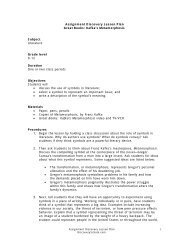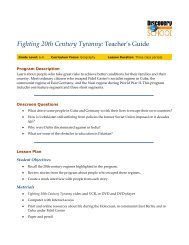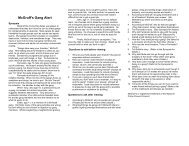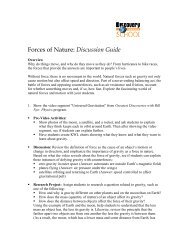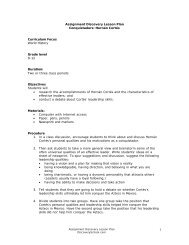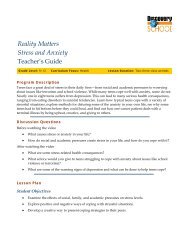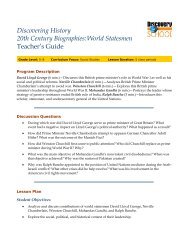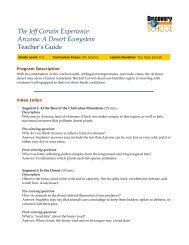Forensic Detectives: Chemistry At Work - Discovery Education
Forensic Detectives: Chemistry At Work - Discovery Education
Forensic Detectives: Chemistry At Work - Discovery Education
Create successful ePaper yourself
Turn your PDF publications into a flip-book with our unique Google optimized e-Paper software.
<strong>Forensic</strong> <strong>Detectives</strong>: <strong>Chemistry</strong> at <strong>Work</strong>: Teacher’s Guide 8<br />
columns of elements are called groups. The elements in each group have similar chemical<br />
properties.<br />
3. <strong>At</strong>oms and Elements<br />
Pre-viewing question<br />
Q: What known element is the most reactive?<br />
A: Answers will vary.<br />
Post-viewing question<br />
Q: What is the makeup of an atom?<br />
A: All atoms have the same make-up—electrons surrounding a central nucleus, which is composed<br />
of particles called protons and neutrons. Electrons carry a negative electrical charge. Protons are<br />
positively charged. Neutrons have a neutral charge.<br />
4. Mysterious Balloons<br />
Pre-viewing question<br />
Q: What’s the most unusual object you’ve seen in the sky?<br />
A: Answers will vary.<br />
Post-viewing question<br />
Q: Why did the military suppress news about the balloons?<br />
A: Answers will vary.<br />
5. Balloon Bomb Science<br />
Pre-viewing question<br />
Q: Who would you guess was sending the balloon bombs?<br />
A: Answers will vary.<br />
Post-viewing question<br />
Q: How did the balloon bombs work?<br />
A: When released, the balloons floated upward. As the sun heated a balloon, it would expand and<br />
rise. But if it expanded too much, it could burst, so a valve opened that would release excess<br />
pressure. As night fell and a balloon cooled, it would descend. But if it dropped too much, it could<br />
crash. To prevent this, an altimeter closed a switch that ignited a charge. The blast released a pair of<br />
sandbags, lightening the load and sending the balloon back up. When all the sand bags had been<br />
released, a final charge would release the bomb.<br />
6. Stopping the Bombs<br />
Pre-viewing question<br />
Q: What can you tell by looking at grains of sand?<br />
A: Answers will vary.<br />
Post-viewing question<br />
Q: How did the sand in the balloon bombs help geologists locate their origin?<br />
A: The sand lacked coral fragments and granite, one of the most common rock types on Earth. It<br />
had high concentrations of rare volcanic minerals and microscopic plant and animal fossils. The<br />
Published by <strong>Discovery</strong> <strong>Education</strong>. © 2005. All rights reserved.



